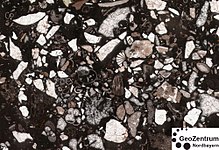
Under the Dunham classification (Dunham, 1962 [1]) system of limestones, a packstone is defined as a grain-supported carbonate rock that contains 1% or more mud-grade fraction. This definition has been clarified by Lokier and Al Junaibi (2016) [2] as a carbonate-dominated lithology containing carbonate mud (<63 μm) in a fabric supported by a sand grade (63 μm to 2 mm) grain-size fraction and where less than 10% of the volume consists of grains >2 mm.
The identification of packstone

A study of the adoption and use of carbonate classification systems by Lokier and Al Junaibi (2016) [2] identified three common problems encountered when describing a packstone:
- Failure to identify the fabric as supported by the sand grade grain-size fraction - resulting in misidentification as wackestone.
- Packstones with very small volumes of carbonate mud may be misclassified as grainstone.
- Incorrectly estimating the volume of the component grains >2 mm.
References
- ^ Dunham, R.J. (1962) Classification of carbonate rocks according to depositional texture. In: Classification of Carbonate Rocks (Ed. W.E. Ham), Am. Assoc. Pet. Geol. Mem., 1, 108–121.
- ^ a b Lokier, Stephen W.; Al Junaibi, Mariam (2016-12-01). "The petrographic description of carbonate facies: are we all speaking the same language?". Sedimentology. 63 (7): 1843–1885. doi: 10.1111/sed.12293. ISSN 1365-3091.